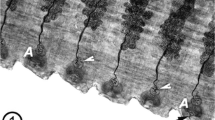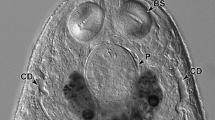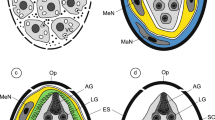Summary
Optical and electron microscope studies of the supposed epitheliocystid Ochetosoma aniarum cercariae indicated that the bladder epithelium was syncytial and did not develop from a “mesodermal” mass as previously noted for epitheliocystid worms. The initial development appeared similar to that described for other epitheliocystid cercariae, except that the lining was cytoplasmic in all stages of development. The bladder epithelium of mature cercariae possessed spongiform secretory granules, nuclei in outpockets distal to the lumen, and appeared secretory in nature. The bladder wall of early embryos did not appear secretory, however it became progressively more secretory appearing as the embryos matured. These findings do not uphold the criteria established by La Rue (1957) for epitheliocystid development, thus casting doubt upon the research that led to La Rue's conclusions.
The protonephridial ducts were similar to those described by others. The larger duct walls possessed finger-like projections into the lumen. Such projections were not seen in the small excretory capillaries.
Similar content being viewed by others
References
Cable, R. M.: “Thereby hangs a tail.” J. Parasit. 51, 3–12 (1965).
Dobrovolny, C. G.: Life history of Plagioporous sinitsini Mueller and embryology of new cotylocercous cercariae (Trematoda). Trans. Amer. microsc. Soc. 58, 121–155 (1939).
Erasmus, D. A.: Ultrastructural observations on the reserve bladder system of Cyathocotyle bushiensis Khan, 1962 (Trematoda: Strigeioidea) with special reference to lipid excretion. J. Parasit. 53, 525–536 (1967).
Hussey, K. L.: Comparative embryological development of the excretory systems in digenetic trematodes. Trans. Amer. microsc. Soc. 60, 171–210 (1941).
Hussey, K. L.: Further studies on the comparative embryological development of the excretory system in digenetic trematodes. Trans. Amer. microsc. Soc. 62, 271–279 (1943).
Kruidenier, F. J.: Ultrastructure of the excretory system of cercariae. J. Parasit. 45 (Supp.), 59 (1959).
Krupa, P. L., Cousineau, G. H., Bal, A. K.: Electron microscopy of the excretory vesicle of a trematode cercaria. J. Parasit. 55, 985–992 (1969).
Kuntz, R. E.: Embryological development of the excretory system in forktailed cercariae of the schistosomes and a blunt tailed brachylaemid cercaria. Trans. Amer. microsc. Soc. 69, 1–20 (1950).
Kuntz, R. E.: Embryonic development of the excretory system in a psilostome cercaria, a gymnophalous (fasciolid) cercaria and in three monostome cercariae. Trans. Amer. microsc. Soc. 70, 95–118 (1951).
Kuntz, R. E.: Embryonic development of the excretory system in a pleurolophocercous (acanthostomid) cercaria, three stylet cercariae (a microcercous cercaria, a brevicaudate, and a longicaudate dicrocoelid cercaria) and in a microcaudate eucotylid cercaria. Trans. Amer. microsc. Soc. 71, 45–81 (1952).
La Rue, G. R.: The classification of digenetic Trematoda: A review and a new system. Exp. Parasit. 6, 306–349 (1957).
Luft, J.: Improvements in epoxy resin embedding methods. J. biophys. biochem. Cytol. 9, 409–414 (1961).
Lundahl, W. S.: Life history of Caecincola parvulus Marshal and Gilbert (Cryptogonimidae, Trematoda) and the development of its excretory system. Trans. Amer. microsc. Soc. 60, 461–484 (1941).
Millonig, G.: Advantages of a phosphate buffer for osmium tetroxide solutions in fixation. J. appl. Phys. 32, 1627 (1961).
Pantelouris, E. M., Threadgold, L. T.: The excretory system of the adult Fasciola hepatica L. Cellule 64, 63–67 (1963).
Rees, G.: Locomotion of the cercaria of Parorchis acanthus Nicoll and the ultrastructure of the tail. Parasitology 62, 489–503 (1971).
Reynolds, E.: The use of lead citrate at high pH as an electron opaque stain in electron microscopy. J. Cell Biol. 17, 208–212 (1963).
Smith, J. H., Reynolds, E. S., Lichtenberg, F. von: The integument of Schistosoma mansoni. Amer. J. trop. Med. Hyg. 18, 28–49 (1969).
Townsend, E. W.: Preliminary report of Echinochasmus sp. (Trematoda) and a comparison of the excretory system of the cercaria with three related species. J. Parasit. 27, 10–11 (1941).
Wallace, H. E.: Life history and embryology of Triganodistomum mutabile Cort (Lissorchiidae, Trematoda). Trans. Amer. microsc. Soc. 60, 309–326 (1941).
Watson, M.: Staining of tissue sections for electron microscopy with heavy metals. J. biophys. biochem. Cytol. 4, 475–478 (1958).
Author information
Authors and Affiliations
Rights and permissions
About this article
Cite this article
Powell, E.C. Optical and electron microscope studies on the excretory bladder of the supposed epitheliocystid cercaria of Ochetosoma aniarum . Z. Parasitenk. 40, 19–30 (1972). https://doi.org/10.1007/BF00329612
Received:
Issue Date:
DOI: https://doi.org/10.1007/BF00329612




